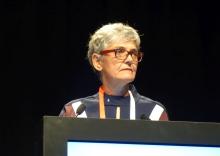STOCKHOLM – Christine Lebrun-Frenay, MD, PhD, reported at the annual congress of the European Committee for Treatment and Research in Multiple Sclerosis.
She and her coinvestigators in the Radiologically Isolated Syndrome Consortium identified four significant risk factors for conversion. The likelihood of developing MS rose stepwise with the number of risk factors present at baseline such that patients possessing all four risk factors had an 87% conversion rate by 10 years.
The four significant risk factors that emerged from multivariate analysis were being age 37 years or younger at the time of the initial abnormal MRI, having spinal cord lesions on MRI, being cerebrospinal fluid positive for oligoclonal immunoglobulin bands and/or an elevated IgG index, and having infratentorial brain lesions on MRI.
Patients with none or one of the risk factors at baseline had a 29% conversion rate at 10 years. That risk climbed to 54% with two risk factors and 68% with any three, according to Dr. Lebrun-Frenay, head of the inflammatory neurologic disorders clinical research unit and MS Center at the University of Nice (France).
The new 10-year results expand upon the previously reported outcomes involving 5 years of prospective follow-up in the initial cohort of 451 RIS patients at participating MS centers in the United States, three European countries, and Turkey. At 5 years, 34% of subjects had converted to MS as defined by a first acute symptomatic clinical event involving CNS demyelination or 12 months of a progressive neurologic deficit (PLoS One. 2014 Mar 5;9[3]:e90509).
Of note, 17% of patients were treated off label with MS disease-modifying therapies, including natalizumab, injectables, or fingolimod, while they still had RIS, she noted.
RIS was defined on the basis of an incidentally identified CNS white-matter lesion meeting the 2009 Okuda criteria (Neurology. 2009 Mar 3;72[9]:800-5), which remain the only validated criteria for RIS.
Fourteen patients converted from RIS to primary progressive MS, indicating the existence of a previously unrecognized presymptomatic phase for this form of the disease.
The mounting conversions from RIS to MS over time suggest that RIS is part of the MS spectrum. In light of the RIS Consortium’s 10-year findings, Dr. Lebrun-Frenay and colleagues strongly recommended yearly monitoring of patients with RIS via a clinical visit including a neurologic examination and possibly a cognitive evaluation, as well as brain and spinal cord MRI scans.
Based on the observed conversion trajectory between 5 and 10 years, Dr. Lebrun-Frenay speculated that with further prospective follow-up eventually all of the RIS patients will develop MS. Despite this, she did not recommend prescribing disease-modifying therapies for these asymptomatic RIS patients. Dr. Lebrun-Frenay noted that there are two ongoing major randomized, phase 3, placebo-controlled clinical trials addressing this very question: the ARISE study of dimethyl fumarate in the United States, and the TERIS study of teriflunomide in Europe.
“It hasn’t been demonstrated yet that to give an active drug at this early stage is useful, so we have to wait a little bit for the results of these ongoing trials. I think we have to believe in evidence-based medicine. After all, 5 or 6 years ago we didn’t have any diagnostic criteria for RIS. We didn’t have any knowledge of this syndrome. Now we have to wait for maybe 2 years. It’s not too long to wait for the answer,” she said.
Dr. Lebrun-Frenay serves as a consultant to more than a half-dozen pharmaceutical companies but reported having no financial conflicts regarding the RIS Consortium study, which is being conducted without commercial support.
SOURCE: Lebrun-Frenay C et al. ECTRIMS 2019, Abstract 97.


